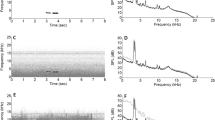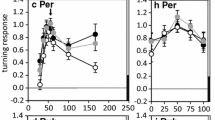Abstract
The two-note fee bee song of the black-capped chickadee (Poecile atricapillus) is sung at many different absolute frequencies, but the relative frequencies, or “pitch ratios”, between the start and end of the fee note (glissando) and the fee and the bee notes (inter-note interval) are preserved with each pitch-shift. Ability to perceive these ratios and their relative salience varies with sex of the bird and setting: while both sexes appear to perceive changes in the inter-note interval, males appear to attend to the glissando in the field, and females appear to attend to both ratios. In this study, we compared directly whether male and female chickadees could discriminate between normal fee bee songs and songs that had one or both of the pitch ratios altered, and whether birds attended to one type of alteration over another. Both sexes learned to discriminate normal from altered songs; songs lacking an inter-note interval were more easily discriminated than songs with only the glissando removed. Females performed slightly better than males, including in the most difficult task with the stimuli lacking the glissando. Our study illustrates the value of using perceptual tasks to directly compare performance between the sexes and to demonstrate the difference between perception of and attention to acoustic features of vocal communication.





Similar content being viewed by others
References
Becker PH (1982) The coding of species—specific characteristics in bird sounds. In: Kroodsma D, Miller E (eds) Acoustic communication in birds, vol 1. Academic Press, New York, pp 213–252
Bloomfield LL, Farrell TM, Sturdy CB (2008) Categorization and discrimination of “chick-a-dee” calls by wild-caught and hand-reared chickadees. Behav Proc 77:166–176
Christie PJ, Mennill DJ, Ratcliffe LM (2004) Pitch shifts and song structure indicate male quality in the dawn chorus of black-capped chickadees. Behav Ecol Sociobiol 55:341–348
Clayton NS, Prove E (1989) Song discrimination in female zebra finches and Bengalese finches. Anim Behav 38:352–362
Cynx J, Hulse SH, Polyzois S (1986) A psychophysical measure of pitch discrimination loss resulting from a frequency range constraint in European starlings (Sturnus vulgaris). J Exp Psychol Anim B 12:394–402
Desrochers A (1990) Sex determination of black-capped chickadees with a discriminant analysis. J Field Ornithol 61:79–84
Dickens MJ, Bentley GE (2014) Stress, captivity, and reproduction in a wild bird species. Horm Behav 66:685–693
Doucet SM, Mennill DJ, Montgomerie R, Boag PT, Ratcliffe LM (2005) Achromatic plumage reflectance predicts reproductive success in male black-capped chickadees. Behav Ecol 16:218–222
Friedrich A, Zentall T, Weisman RG (2007) Absolute pitch: frequency-range discriminations in pigeons (Columba livia): comparisons with zebra finches (Taeniopygia guttata) and humans (Homo sapiens). J Comp Psychol 121:95–105
Hahn AH, Hoeschele M, Guillette LM, Hoang J, McMillan N, Congdon JV, Campbell K, Mennill DJ, Otter KA, Grava T, Ratcliffe LM, Sturdy CB (2016) Black-capped chickadees categorize songs based on features that vary geographically. Anim Behav 112:94–104
Hoeschele M, Guillette LM, Sturdy CB (2012) Biological relevance of acoustic signal affects discrimination performance in a songbird. Anim Cogn 15:677–688
Hulse SH, Cynx J (1985) Relative pitch perception is constrained by absolute pitch in songbirds (Mimus, Molothrus, and Sturnus). J Comp Psychol 99:176–196
Hurly TA, Ratcliffe L, Weary D, Weisman R (1992) White-throated sparrows (Zonotrichia albicollis) can perceive pitch change in conspecific song by using the frequency ratio independent of the frequency difference. J Comp Psychol 106:388–391
Kroodsma DE, Byers BE, Halkin SL, Hill C, Minis D, Bolsinger JR, Dawson JA, Donelan E, Farrington J, Gill FB, Houlihan P, Innes D, Keller G, Macaulay L, Marantz CA, Ortiz J, Stoddard PK, Wilda K (1999) Geographic variation in black-capped chickadee songs and singing behavior. Auk 116:387–402
Leitner S, Catchpole CK (2002) Female canaries that respond and discriminate more between male songs of different quality have a larger song control nucleus (HVC) in the brain. J Neurobiol 52:294–301
Maney D, Pinaud R (2011) Estradiol-dependent modulation of auditory processing and selectivity in songbirds. Front Neuroendocrinol 32:287–302
McMillan N, Hahn A, Congdon JV, Campbell KA, Hoang J, Scully EN, Spetch ML, Sturdy CB (2017) Chickadees discriminate contingency reversals presented consistently, but not frequently. Anim Cogn. doi:10.1007/s10071-017-1088-4
Mennill DJ, Ramsay SM, Boag PT, Ratcliffe LM (2004) Patterns of extrapair mating in relation to male dominance status and female nest placement in black-capped chickadees. Behav Ecol 15:757–765
Naguib M, Wiley RH (2001) Estimating the distance to a source of sound: mechanisms and adaptations for long-range communication. Anim Behav 62:825–837
Njegovan M, Weisman RG (1997) Pitch discrimination in field- and isolation-reared black-capped chickadees (Parus atricapillus). J Comp Psychol 111:294–301
Otter K, Ratcliffe L, Michaud D, Boag PT (1998) Do female black-capped chickadees prefer high-ranking males as extra-pair partners? Behav Ecol Sociobiol 43:25–36
Phillmore LS, Sturdy CB, Turyk MM, Weisman RG (2002) Discrimination of individual vocalizations by black-capped chickadees (Poecile atricapilla). Anim Learn Behav 30:43–52
Phillmore LS, Bloomfield LL, Weisman RG (2003) Effects of songs and calls on ZENK expression in the auditory telencephalon of field- and isolate-reared black capped chickadees. Behav Brain Res 147:125–134
Phillmore LS, Veysey AS, Roach SP (2011) Zenk expression in auditory regions changes with breeding condition in male black-capped chickadees (Poecile atricapillus). Behav Brain Res 225:464–472
Pyle P (1997) Identification guide to North American birds, Part 1. Slate Creek Press, Bolinas
Ratcliffe LM, Otter KA (1996) Sex differences in song recognition. In: Kroodsma DE, Miller EH (eds) Ecology and evolution of acoustic communication among birds. Cornell University Press, New York, pp 339–355
Roach SP, Lockyer AC, Yousef T, Mennill DJ, Phillmore LS (2016) Vocal production and playback of altered song do not affect ZENK expression in black-capped chickadees (Poecile atricapillus). Behav Brain Res 298:91–99
Searcy WA (1996) Sound-pressure levels and song preferences in female red-winged blackbirds (Agelaius phoeniceus) (Aves, Emberizidae). Ethology 102:187–196
Shackleton SA, Ratcliffe L, Weary DM (1992) Relative frequency parameters and song recognition in black-capped chickadees. Condor 94:782–785
Sokal RR, Rohlf FJ (1981) Biometry, 2nd edn. W.H. Freedman, New York
Sturdy CB, Weisman RG (2006) Rationale and methodology for testing auditory cognition in songbirds. Behav Proc 72:265–272
Weary DM, Weisman RG (1991) Operant discrimination of frequency and frequency ratio in the black-capped chickadee (Parus atricapillus). J Comp Psychol 105:253–259
Weary DM, Norris KJ, Falls JB (1990) Song features birds use to identify individuals. Auk 107:623–625
Weary DM, Weisman RG, Lemon RE, Chin T, Mongrain J (1991) Use of the relative frequency of notes by veeries in song recognition and production. Auk 108:977–981
Weisman RG, Ratcliffe LM (1989) Absolute and relative pitch processing in black-capped chickadees, Parus atricapillus. Anim Behav 38:685–692
Weisman RG, Ratcliffe L, Johnsrude I, Hurly TA (1990) Absolute and relative pitch production in the song of the black-capped chickadee. Condor 92:118–124
Weisman RG, Hoeschele M, Bloomfield LL, Mewhort D, Sturdy CB (2010) Using network models of absolute pitch to compare frequency-range discriminations across avian species. Behav Process 84:421–427
Acknowledgements
Thank you to all private property owners in the Halifax region who allowed us to capture birds and to Sean Aitken and Jordan Fisk for helping collect data.
Funding
This research was supported by NSERC DG 326869-2012 to LSP.
Author information
Authors and Affiliations
Corresponding author
Ethics declarations
Conflict of interest
All authors declare they have no conflict of interest.
Ethical approval
All methods and procedures were approved by the University Committee on Lab Animals at Dalhousie in accordance with Canadian Council on Animal Care guidelines: Protocol # 12-023.
Rights and permissions
About this article
Cite this article
Roach, S.P., Mennill, D.J. & Phillmore, L.S. Operant discrimination of relative frequency ratios in black-capped chickadee song. Anim Cogn 20, 961–973 (2017). https://doi.org/10.1007/s10071-017-1115-5
Received:
Revised:
Accepted:
Published:
Issue Date:
DOI: https://doi.org/10.1007/s10071-017-1115-5




